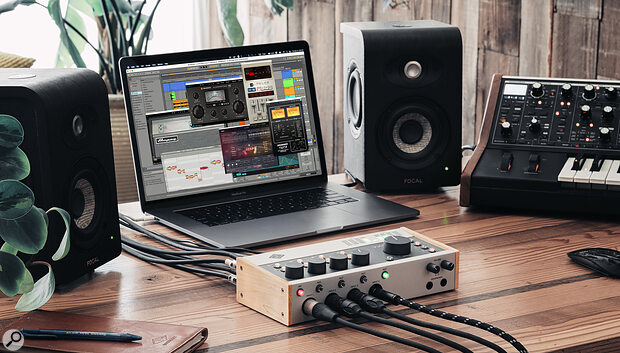UA’s Volt range welcomes two additional members, including a new flagship.
It’s almost a year since Universal Audio made their entry into the affordable sector of the audio interface market. At launch, the Volt range comprised five bus‑powered USB designs, featuring simple direct monitoring features. Volt mic preamps offer a Vintage mode for additional colour, and the ‘76’ models include simple preset analogue compressors too.
Unlike, say, Focusrite’s Scarlett range, the initial Volt line‑up didn’t span a wide range of I/O counts or form factors. Even the top‑of‑the‑range 476 offered just two mic preamps and two additional line inputs, and with only the one headphone amp, is targeted at self‑recordists rather than people tracking bands.
However, the Volt family has now swelled, with two new members joining the ranks. The Volt 4 has the same I/O count as the existing Volt 476, but with the plainer cosmetics and case of the other non‑76 models, and no compressors. The 476P, though, is the first Volt apparently aimed at recording situations involving more than one person. It has four analogue input channels, all with mic preamps and compressors. And on the output side, it boasts a main pair of monitor outputs, four additional line outputs and two front‑panel headphone sockets. I received both new interfaces for testing, but will focus on the 476P in this review.
The extra I/O opens up possibilities that aren’t available with its siblings. The second headphone output, in particular, makes this an ideal tool for collaborative recording.
High Voltage
Extending the Volt x76 case to accommodate the extra channels has produced an attractive design, and having the meters and controls on the top surface yields obvious ergonomic benefits compared with the non‑76 models. Like the other Volts, the 476P can be bus‑powered, but a 5V PSU is included in case your computer can’t supply the necessary flow of electrons.
When I first looked at the Volt line‑up in SOS December 2021, audio specifications were not available. They’ve since been published, and the headline figures include A‑weighted dynamic range of 112dB on the mic inputs and 110dB on the outputs. The gain range of the inputs is 55dB and the maximum input level is 9dBu in mic mode or 22dBu in line mode. All of these are respectable numbers, but the maximim input level is arguably on the low side for loud miked‑up sources. To test this, I tracked a drum kit using inputs 1 and 2 for kick and snare, and 3 and 4 for the overheads. I had no problems with clipping as long as I stuck with moving‑coil mics on kick and snare, and the flip side of the relatively limited input headroom is that there’s plenty of gain available for quieter signals such as spoken word. Switching in the compressor does produce a little hiss, which can become more noticeable when several are engaged; this is because, like the 1176 on which it’s based, it uses a FET as the gain‑reduction device, meaning the signal needs to be attenuated before hitting the FET and boosted again on the way out.
Like the other Volts, the 476P implements direct monitoring in hardware. There are four possible sources that can be monitored directly: inputs 1+2, inputs 3+4, outputs 1+2 and outputs 3+4. These can be switched in and out in any combination using dedicated buttons, and another button collapses the inputs to mono in the monitor path. However, there’s no way to alter the balance between input and output signals, and the headphones and main monitors always share the same signal.
Conclusion
With no digital expansion, nor any means of doing sophisticated cue mixes, the Volt 476P is probably too limited for full band recording, and it won’t take any market share from UA’s Apollo range. Nevertheless, it will cope with most sources short of a full multi‑miked drum kit, comes with the same tempting suite of plug‑ins as the other Volts, and the extra I/O opens up possibilities that aren’t available with its siblings. The second headphone output, in particular, makes this an ideal tool for collaborative recording, and I’m sure it will prove very popular in that role.
Summary
A stylish and capable USB interface designed for collaborative production.
Information
Volt 476P £405, Volt 4 £225. Prices include VAT.
Volt 476P $169; Volt 4 $239.

